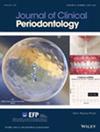Ultra-Processed Foods Reduction Enhances Clinical Outcomes and Dietary Profiles in Patients With Gingivitis: Results From a Randomised Controlled Trial.
IF 6.8
1区 医学
Q1 DENTISTRY, ORAL SURGERY & MEDICINE
引用次数: 0
Abstract
AIM To evaluate the impact of ultra-processed foods reduction advice (UPF-RA) on gingivitis treatment and dietary patterns. METHODS Young adults with gingivitis were randomly assigned to two groups. At baseline, test group participants received UPF-RA. At 8 weeks, professional mechanical plaque removal (PMPR) was carried out, followed by UPF-RA (test group only). Full-mouth periodontal charting and dietary data, collected through the NOVA Food Frequency Questionnaire and the Medi-Lite, were recorded at baseline and at 8 and 16 weeks. RESULTS Sixty-six patients (mean age: 23.3 ± 2.3 years; 32 males and 34 females) were included. At 8 weeks, a significant reduction in full-mouth bleeding score (FMBS) was observed in the test group (18.9% ± 8.6% to 14.6% ± 9.0%; p = 0.04), with a concomitant decrease in UPF intake (912.7 ± 511.3 kcal to 446.9 ± 264.6 kcal; p < 0.001). No significant changes in FMBS and UPF consumption were observed in the control group (19.8% ± 9.0% to 19.1% ± 8.6%, p = 0.93; 776.4 ± 453.6 kcal to 775.3 ± 451.03, p = 1.00, respectively). At 16 weeks, gingivitis was resolved in 24% more cases in the test group. Logistic regression identified low UPF intake and UPF-RA as significant predictors of FMBS reduction. CONCLUSIONS Reduction in UPF consumption improved gingivitis treatment outcomes and participants' dietary quality. Patients with higher UPF consumption showed higher bleeding scores.减少超加工食品可提高牙龈炎患者的临床结果和饮食特征:来自一项随机对照试验的结果
目的评估超加工食品减少建议(UPF-RA)对牙龈炎治疗和饮食模式的影响。方法将患有牙龈炎的青少年随机分为两组。在基线时,试验组参与者接受UPF-RA。8周时,进行专业机械斑块清除(PMPR),随后进行UPF-RA(仅试验组)。通过NOVA食物频率问卷和medii - lite收集的全口牙周图表和饮食数据在基线、8周和16周时被记录下来。结果共纳入66例患者,平均年龄23.3±2.3岁,男32例,女34例。8周时,试验组全口出血评分(FMBS)显著降低(18.9%±8.6%至14.6%±9.0%,p = 0.04), UPF摄入量降低(912.7±511.3 kcal至446.9±264.6 kcal, p < 0.001)。对照组FMBS和UPF消耗无显著变化(19.8%±9.0%至19.1%±8.6%,p = 0.93; 776.4±453.6 kcal至775.3±451.03 kcal, p = 1.00)。16周时,试验组牙龈炎消退的病例比对照组多24%。逻辑回归发现低UPF摄入量和UPF- ra是FMBS减少的重要预测因素。结论:减少UPF的摄入改善了牙龈炎的治疗效果和参与者的饮食质量。UPF用量较高的患者出血评分较高。
本文章由计算机程序翻译,如有差异,请以英文原文为准。
求助全文
约1分钟内获得全文
求助全文
来源期刊

Journal of Clinical Periodontology
医学-牙科与口腔外科
CiteScore
13.30
自引率
10.40%
发文量
175
审稿时长
3-8 weeks
期刊介绍:
Journal of Clinical Periodontology was founded by the British, Dutch, French, German, Scandinavian, and Swiss Societies of Periodontology.
The aim of the Journal of Clinical Periodontology is to provide the platform for exchange of scientific and clinical progress in the field of Periodontology and allied disciplines, and to do so at the highest possible level. The Journal also aims to facilitate the application of new scientific knowledge to the daily practice of the concerned disciplines and addresses both practicing clinicians and academics. The Journal is the official publication of the European Federation of Periodontology but wishes to retain its international scope.
The Journal publishes original contributions of high scientific merit in the fields of periodontology and implant dentistry. Its scope encompasses the physiology and pathology of the periodontium, the tissue integration of dental implants, the biology and the modulation of periodontal and alveolar bone healing and regeneration, diagnosis, epidemiology, prevention and therapy of periodontal disease, the clinical aspects of tooth replacement with dental implants, and the comprehensive rehabilitation of the periodontal patient. Review articles by experts on new developments in basic and applied periodontal science and associated dental disciplines, advances in periodontal or implant techniques and procedures, and case reports which illustrate important new information are also welcome.
 求助内容:
求助内容: 应助结果提醒方式:
应助结果提醒方式:


